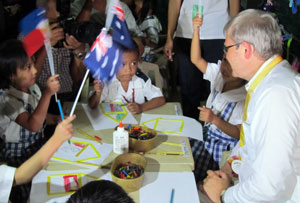Australian expertise and aid is helping transform the lives of thousands of poor Filipino families living in crowded urban areas vulnerable to flooding and natural disasters.
As part of a two-day visit to the Philippines last week, Foreign Minister Kevin Rudd visited Taguig City in Metro Manila, where Australia will help provide around 9,000 people with safe housing and access to water, sanitation, roads and electricity, while also assisting with broader land-use planning, and community disaster-preparedness training.
The BRACE Program (Building the Resilience and Awareness of Metro Manila Communities to Natural Disasters and Climate Change Impacts) is being piloted in Taguig City and will assist city planning with state-of-the-art digital elevation maps to model risks and vulnerability from flooding, earthquakes and high wind. BRACE will also assist with the rehabilitation of major drainage canals and waterways that will benefit thousands of poor in Taguig.
The Philippines is the third most vulnerable country to natural disasters in the world, with an average of 20 typhoons making landfall annually, five to seven of which are destructive.
Disasters pose a major threat to the economy and the welfare of the poor, particularly in dense urban settings like Metro Manila.
"Recent disasters, such as Typhoons Quiel and Pedring which have killed 101 people, affected 4.2 million, and left a damage bill of $333 million, reinforce the terrible cost of natural disasters in the Philippines. While we cannot stop earthquakes, typhoons or flooding rains, we can act to limit the loss of life, hardship and economic damage they regularly cause," Mr Rudd said.
Australia and Taguig City will each contribute $31.5 million to BRACE, and Australia will also work with local organisations, such as the internationally renowned Gawad Kalinga, which provide cost-effective, safe housing for the poor.
"In genuine partnership with Taguig City and organisations such as Gawad Kalinga, we are investing in practical measures to ensure Filipino communities are safer and more disaster-resilient. It is hoped Taguig will serve as a model for other cities in Metro Manila," said Mr Rudd.
Taguig is home to about 25,000 poor, informal settler families, many of whom live in dangerous locations not fit for human habitation.
Unlike many other areas in Metro Manila, Taguig City has ample land available for low-cost public housing. Large parts of Taguig City are also undeveloped or underdeveloped, which allows a greenfield approach to land use planning informed by risk and vulnerability assessment.
Taguig City has agreed to meet 50 per cent of the costs of the program, including providing land for social housing developments and the full range of basic urban services and infrastructure.
The BRACE program is expected to begin early next year.
According to the National Economic and Development Agency (NEDA), Australia is now the largest grant donor to the Philippines.
Australian aid to the Philippines has doubled over the past five years. During 2011-12 our aid program is estimated to be worth $123.1 million.
As well as supporting disaster risk management, Australian aid focuses on reducing poverty in the Philippines through:
- supporting basic education
- improving local government capacity to deliver basic services
- improving the prospects for peace and security
- supporting accountable, transparent and effective governance

